Improved High-Yield PMMA/Graphene Pressure Sensor and Sealed Gas Effect Analysis
Abstract
1. Introduction
2. Device Fabrication and Measurement Setup
2.1. Device Fabrication
2.2. Measurement Setup
3. Results and Discussion
3.1. Improved Performance of PMMA/Graphene Pressure with Through-Hole
3.2. Sealed Gas Effect Analysis
4. Conclusions
Author Contributions
Funding
Acknowledgments
Conflicts of Interest
References
- Javed, Y. A Review of Principles of Mems Pressure Sensing with Its Aerospace Applications. Sens. Rev. 2019, 39, 652–664. [Google Scholar] [CrossRef]
- Chen, W.W.; Yan, X. Progress in Achieving High-Performance Piezoresistive and Capacitive Flexible Pressure Sensors: A Review. J. Mater. Sci. Technol. 2020, 43, 175–188. [Google Scholar] [CrossRef]
- Song, P.P.; Ma, Z.Z.; Ma, J.J.; Yang, L.L.; Wei, J.J.; Zhao, Y.Y.; Zhang, M.M.; Yang, F.F.; Wang, X. Recent Progress of Miniature Mems Pressure Sensors. Micromachines 2020, 11, 56. [Google Scholar] [CrossRef] [PubMed]
- Zhang, J.J.; Chen, J.J.; Li, M.M.; Ge, Y.Y.; Wang, T.T.; Shan, P.P.; Mao, X. Design, Fabrication, and Implementation of an Array-Type Mems Piezoresistive Intelligent Pressure Sensor System. Micromachines 2018, 9, 104. [Google Scholar] [CrossRef]
- Escudero, P.P.; Yeste, J.J.; Pascual-Izarra, C.C.; Villa, R.R.; Alvarez, M. Color Tunable Pressure Sensors Based on Polymer Nanostructured Membranes for Optofluidic Applications. Sci. Rep. 2019, 9, 3259. [Google Scholar] [CrossRef]
- Meyer, J.C.C.; Geim, A.K.K.; Katsnelson, M.I.I.; Novoselov, K.S.S.; Booth, T.J.J.; Roth, S. The Structure of Suspended Graphene Sheets. Nature 2007, 446, 60–63. [Google Scholar] [CrossRef]
- Geim, A.K.K.; Novoselov, K.S. The Rise of Graphene. Nat. Mater. 2007, 6, 183–191. [Google Scholar] [CrossRef]
- Lee, C.C.; Wei, X.X.; Kysar, J.W.W.; Hone, J. Measurement of the Elastic Properties and Intrinsic Strength of Monolayer Graphene. Science 2008, 321, 385–388. [Google Scholar] [CrossRef]
- Kim, K.S.S.; Zhao, Y.Y.; Jang, H.H.; Lee, S.Y.Y.; Kim, J.M.M.; Kim, K.S.S.; Ahn, J.-H.H.; Kim, P.P.; Choi, J.-Y.Y.; Hong, B.H. Large-Scale Pattern Growth of Graphene Films for Stretchable Transparent Electrodes. Nature 2009, 457, 706–710. [Google Scholar] [CrossRef]
- Cocco, G.G.; Cadelano, E.E.; Colombo, L. Gap Opening in Graphene by Shear Strain. Phys. Rev. B 2010, 81, 241412. [Google Scholar] [CrossRef]
- Bunch, J.S.S.; Verbridge, S.S.S.; Alden, J.S.S.; Van Der Zande, A.M.; Parpia, J.M.; Craighead, H.G.; McEuen, P.L. Impermeable Atomic Membranes from Graphene Sheets. Nano Lett. 2008, 8, 2458–2462. [Google Scholar] [CrossRef]
- Smith, A.D.; Niklaus, F.; Paussa, A.; Vaziri, S.; Fischer, A.C.; Sterner, M.; Forsberg, F.; Delin, A.; Essen, D.; Palestri, P.; et al. Electromechanical Piezoresistive Sensing in Suspended Graphene Membranes. Nano Lett. 2013, 13, 3237–3242. [Google Scholar] [CrossRef] [PubMed]
- Aguilera-Servin, J.; Miao, T.; Bockrath, M. Nanoscale Pressure Sensors Realized from Suspended Graphene Membrane Devices. Appl. Phys. Lett. 2015, 106, 083103. [Google Scholar] [CrossRef]
- Li, M.; Zhang, T.; Wang, P.; Li, M.; Wang, J.; Liu, Z. Temperature Characteristics of a Pressure Sensor Based on Bn/Graphene/Bn Heterostructure. Sensors 2019, 19, 2223. [Google Scholar] [CrossRef] [PubMed]
- Milovanović, S.P.; Tadić, M.Ž.; Peeters, F.M. Graphene Membrane as a Pressure Gauge. Appl. Phys. Lett. 2017, 111, 043101. [Google Scholar] [CrossRef]
- Lin, X.; Liu, Y.; Zhang, Y.; Yang, P.; Cheng, X.; Qiu, J.; Liu, G. Polymer-Assisted Pressure Sensor with Piezoresistive Suspended Graphene and Its Temperature Characteristics. Nano 2019, 14, 1950130. [Google Scholar] [CrossRef]
- Li, M.; Wu, C.; Zhao, S.; Deng, T.; Wang, J.; Liu, Z.; Wang, L.; Wang, G. Pressure Sensing Element Based on the Bn–Graphene–Bn Heterostructure. Appl. Phys. Lett. 2018, 112, 143502. [Google Scholar] [CrossRef]
- Chen, Y.; Gong, X.L.; Gai, J.G. Progress and Challenges in Transfer of Large-Area Graphene Films. Adv. Sci. 2016, 3, 1500343. [Google Scholar] [CrossRef]
- Alemán, B.; Regan, W.; Aloni, S.; Altoe, V.; Alem, N.; Girit, C.; Geng, B.; Maserati, L.; Crommie, M.; Wang, F.; et al. Transfer-Free Batch Fabrication of Large-Area Suspended Graphene Membranes. ACS Nano 2010, 4, 4762–4768. [Google Scholar] [CrossRef]
- Biró, L.P.; Lambin, P. Grain Boundaries in Graphene Grown by Chemical Vapor Deposition. New J. Phys. 2013, 15, 035024. [Google Scholar] [CrossRef]
- Balasubramanian, K.; Biswas, T.; Ghosh, P.; Suran, S.; Mishra, A.; Mishra, R.; Sachan, R.; Jain, M.; Varma, M.; Pratap, R.; et al. Reversible Defect Engineering in Graphene Grain Boundaries. Nat. Commun. 2019, 10, 1090. [Google Scholar] [CrossRef] [PubMed]
- Smith, A.D.; Niklaus, F.; Paussa, A.; Schröder, S.; Fischer, A.C.; Sterner, M.; Wagner, S.; Vaziri, S.; Forsberg, F.; Esseni, D.; et al. Piezoresistive Properties of Suspended Graphene Membranes under Uniaxial and Biaxial Strain in Nanoelectromechanical Pressure Sensors. ACS Nano 2016, 10, 9879–9886. [Google Scholar] [CrossRef] [PubMed]
- Melvås, P.; Kälvesten, E.; Enoksson, P.; Stemme, G. A Free-Hanging Strain-Gauge for Ultraminiaturized Pressure Sensors. Sens. Actuators A Phys. 2002, 97, 75–82. [Google Scholar] [CrossRef]
- Stampfer, C.; Helbling, T.; Obergfell, D.; Sch?berle, B.; Tripp, M.K.; Jungen, A.; Roth, S.; Bright, V.M.; Hierold, C.J.N.L. Fabrication of Single-Walled Carbon-Nanotube-Based Pressure Sensors. Nano Lett. 2006, 6, 233–237. [Google Scholar] [CrossRef] [PubMed]
- González, P.C.; Rakowski, M.; Segundo, D.S.; Severi, S.; Meyer, K.D.; Witvrouw, A. Cmos-Integrated Poly-Sige Piezoresistive Pressure Sensor. IEEE Electron Device Lett. 2012, 33, 1204–1206. [Google Scholar] [CrossRef]
- Godovitsyn, I.V.; Amelichev, V.V.; Pankov, V.V. A High Sensitivity Surface-Micromachined Pressure Sensor. Sens. Actuators A Phys. 2013, 201, 274–280. [Google Scholar] [CrossRef]
- Davidovikj, D.; Scheepers, P.H.; van der Zant, H.S.; Steeneken, P.G. Static Capacitive Pressure Sensing Using a Single Graphene Drum. ACS Appl. Mater. Interfaces 2017, 9, 43205–43210. [Google Scholar] [CrossRef]
- Bunch, J.S. Mechanical and Electrical Properties of Graphene Sheets. Ph.D. Thesis, Cornell University, Ithaca, NY, USA, 2008. [Google Scholar]
- Polyanin, A.; Manzhirov, A. Handbook of Mathematics for Engineers and Scientists; CRC Press: Boca Raton, FL, USA, 2006; p. 69. [Google Scholar]
- West, J.B. Robert Boyle’s Landmark Book of 1660 with the First Experiments on Rarified Air. J. Appl. Physiol. 2005, 98, 31–39. [Google Scholar] [CrossRef]

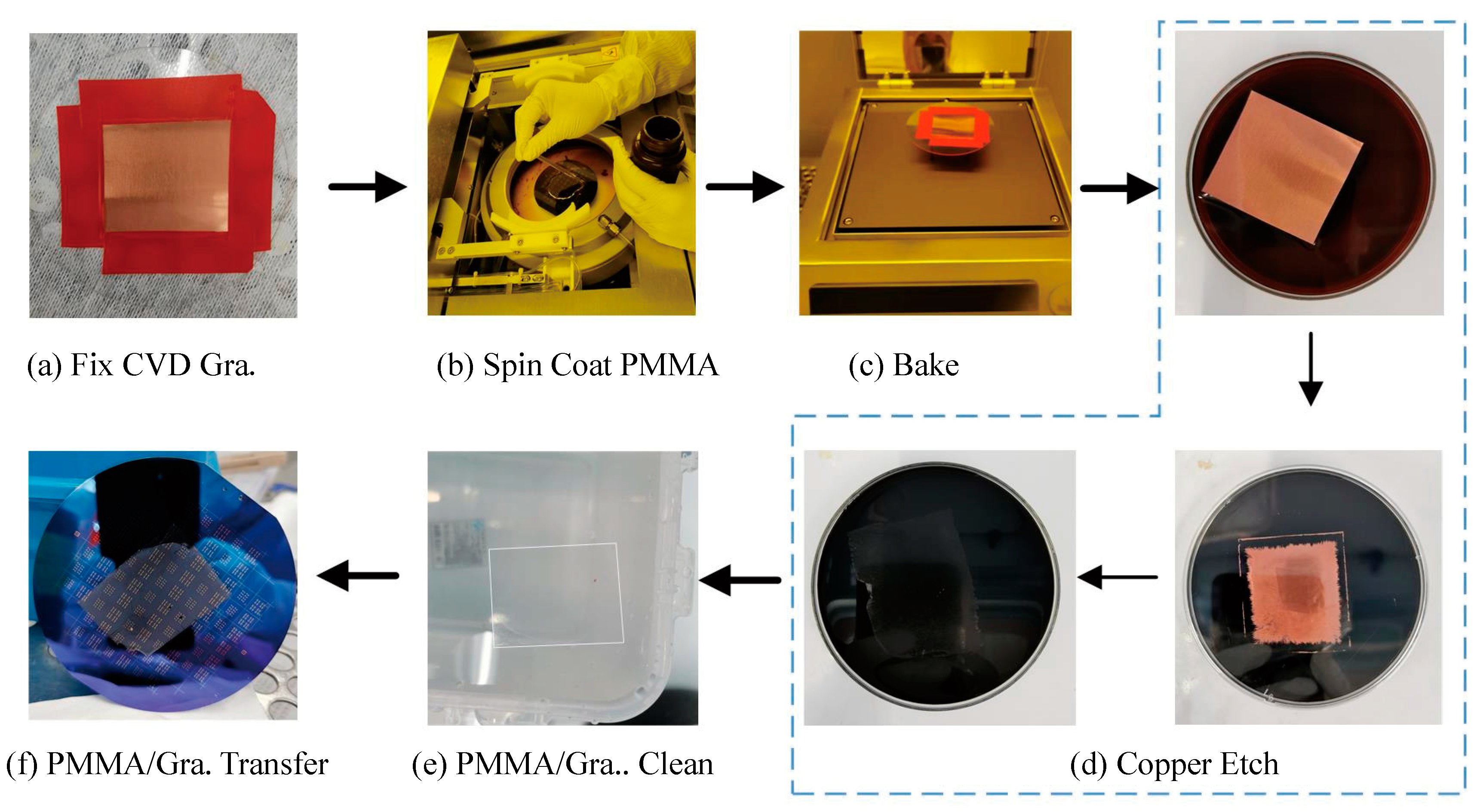

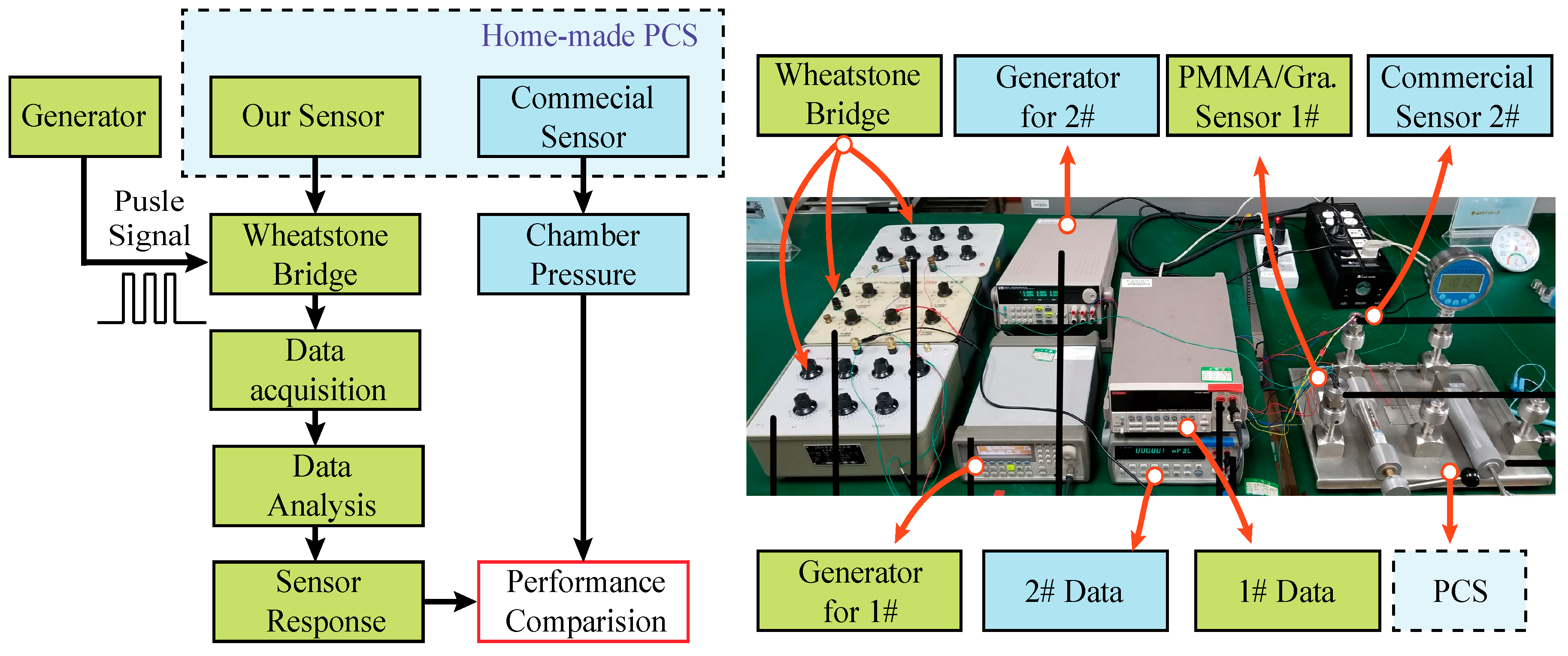
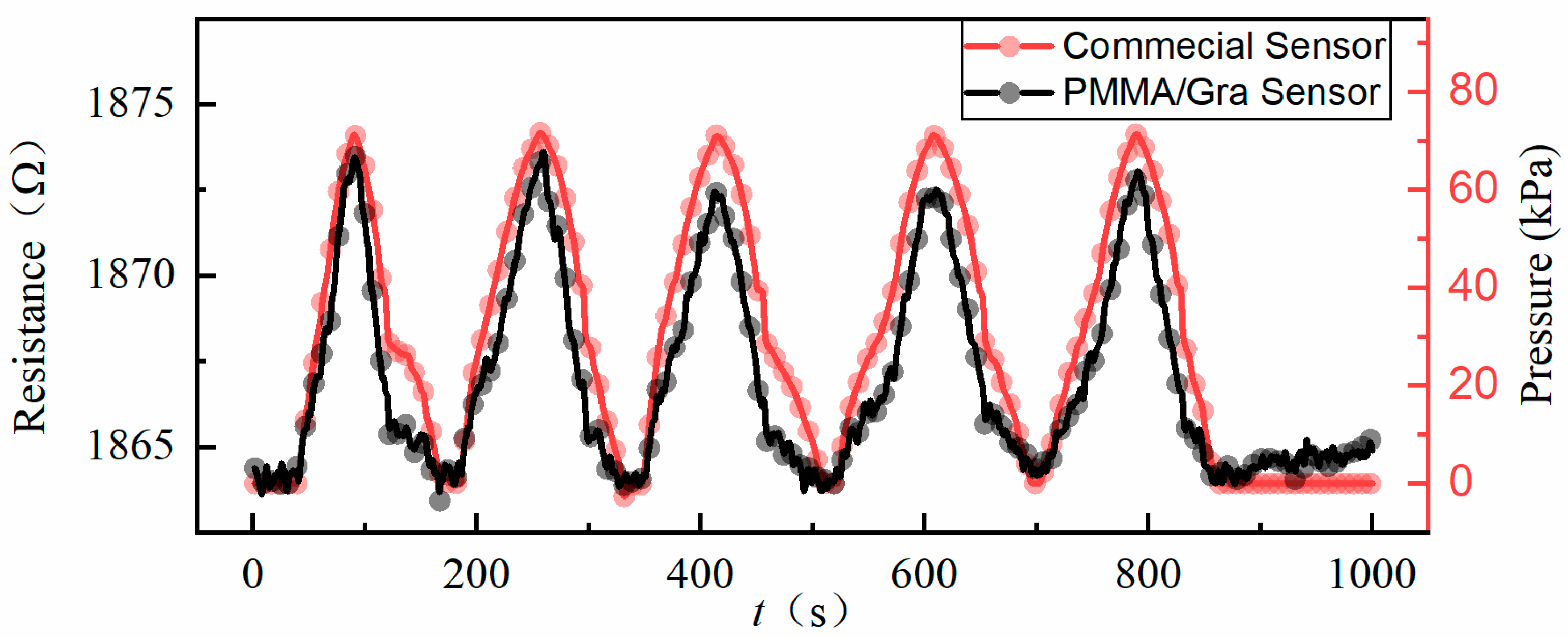
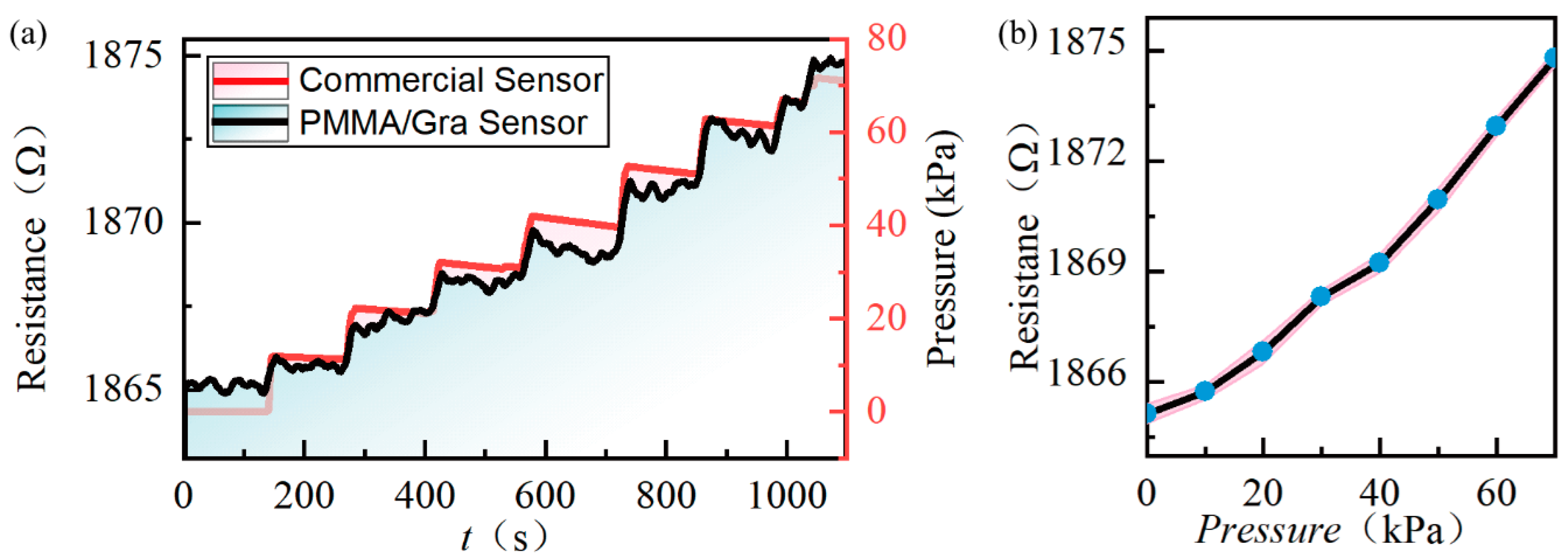
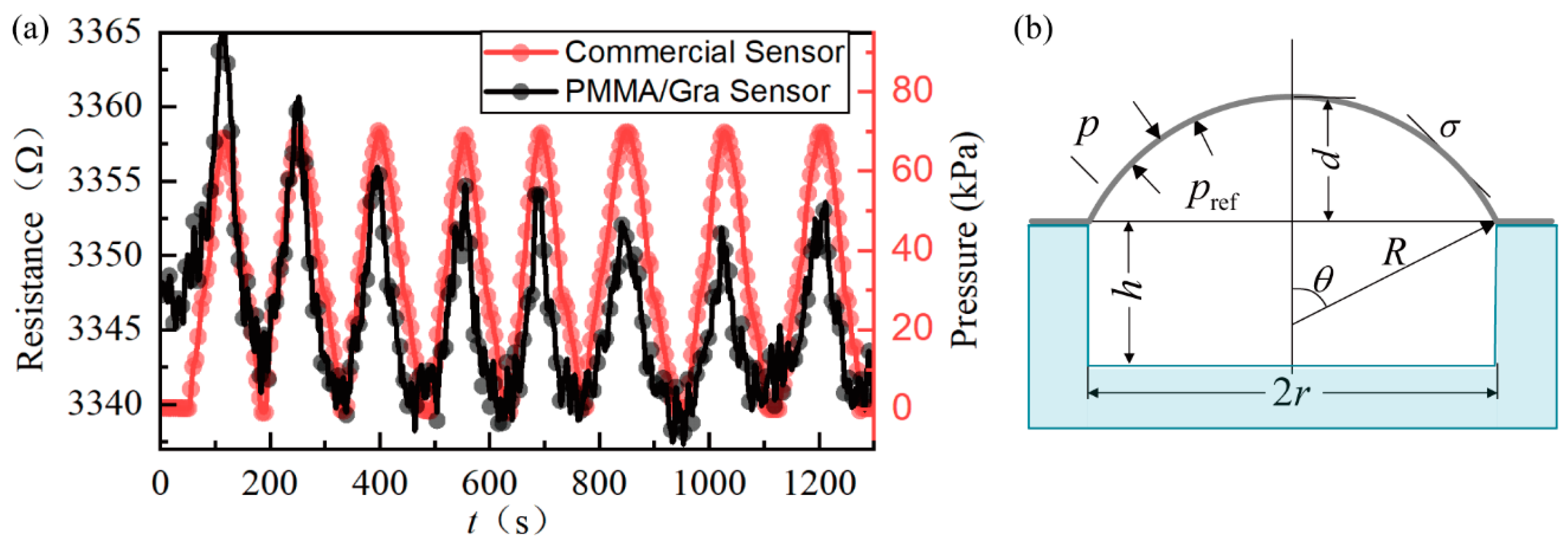
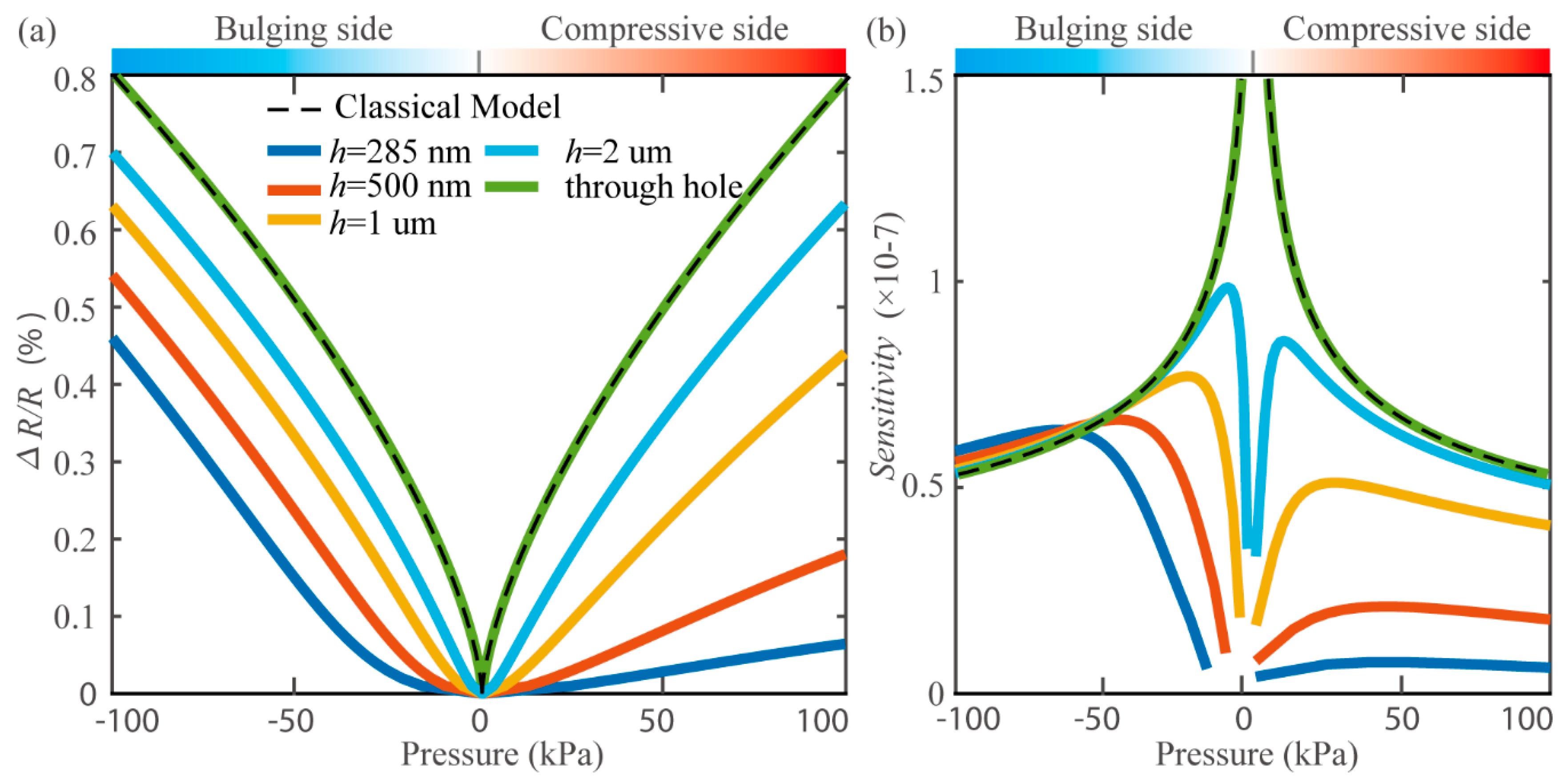
| Group | Year | Material | Size μm | Range kPa | Sensitivity /kPa | Sensitivity Per Unit Area/kPa |
|---|---|---|---|---|---|---|
| Melvas [23] | 2002 | Si | 100 × 100 | 10~140 | 3.75 × 10−5 | 3.75 × 10−9 |
| Hierold [24] | 2007 | Al2O3/CNT | r = 100 | 0~130 | 6.53 × 10−5 | 2.08 × 10−9 |
| Gonzalez [25] | 2012 | SiGe | 200 × 200 | 0~100 | 4.60 × 10−5 | 1.15 × 10−9 |
| Godovitsyn [26] | 2013 | Si | 2000 × 2000 | 0~100 | 2.37 × 10−4 | 5.92 × 10−11 |
| Smith [12] | 2013 | Graphene | 6 × 64 | 40~100 | 2.96 × 10−5 | 7.71 × 10−8 |
| This paper | 2019 | Graphene | r = 8 | 0~70 | 7.42 × 10−5 | 12.30 × 10−8 |
© 2020 by the authors. Licensee MDPI, Basel, Switzerland. This article is an open access article distributed under the terms and conditions of the Creative Commons Attribution (CC BY) license (http://creativecommons.org/licenses/by/4.0/).
Share and Cite
Liu, Y.; Zhang, Y.; Lin, X.; Lv, K.-h.; Yang, P.; Qiu, J.; Liu, G.-j. Improved High-Yield PMMA/Graphene Pressure Sensor and Sealed Gas Effect Analysis. Micromachines 2020, 11, 786. https://doi.org/10.3390/mi11090786
Liu Y, Zhang Y, Lin X, Lv K-h, Yang P, Qiu J, Liu G-j. Improved High-Yield PMMA/Graphene Pressure Sensor and Sealed Gas Effect Analysis. Micromachines. 2020; 11(9):786. https://doi.org/10.3390/mi11090786
Chicago/Turabian StyleLiu, Ying, Yong Zhang, Xin Lin, Ke-hong Lv, Peng Yang, Jing Qiu, and Guan-jun Liu. 2020. "Improved High-Yield PMMA/Graphene Pressure Sensor and Sealed Gas Effect Analysis" Micromachines 11, no. 9: 786. https://doi.org/10.3390/mi11090786
APA StyleLiu, Y., Zhang, Y., Lin, X., Lv, K.-h., Yang, P., Qiu, J., & Liu, G.-j. (2020). Improved High-Yield PMMA/Graphene Pressure Sensor and Sealed Gas Effect Analysis. Micromachines, 11(9), 786. https://doi.org/10.3390/mi11090786






